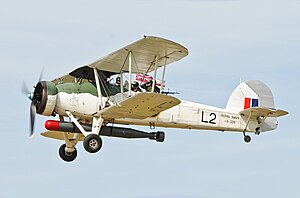
Back Fairey Swordfish Afrikaans فيري سوردفيش Arabic Fairey Swordfish Bulgarian ফেয়ারি সোর্ডফিশ Bengali/Bangla Fairey Swordfish Catalan Fairey Swordfish Czech Fairey Swordfish Danish Fairey Swordfish German Fairey Swordfish Greek Fairey Swordfish Spanish
| Swordfish | |
|---|---|
 Swordfish LS 326 in flight in 2013 | |
| General information | |
| Type | Torpedo bomber |
| National origin | United Kingdom |
| Manufacturer | Fairey |
| Built by | Fairey, Blackburn Aircraft |
| Primary users | Fleet Air Arm, Royal Navy |
| Number built | 2,391 (692 by Fairey and 1,699 by Blackburn) |
| History | |
| Manufactured | 1936–1944 |
| Introduction date | 1936 |
| First flight | 17 April 1934 |
| Retired | 21 May 1945 |
The Fairey Swordfish was a biplane torpedo bomber, designed by the Fairey Aviation Company. Originating in the early 1930s, the Swordfish, nicknamed "Stringbag", was principally operated by the Fleet Air Arm of the Royal Navy. It was also used by the Royal Air Force (RAF), as well as several overseas operators, including the Royal Canadian Air Force (RCAF) and the Royal Netherlands Navy. It was initially operated primarily as a fleet attack aircraft. During its later years, the Swordfish was increasingly used as an anti-submarine and training platform. The type was in frontline service throughout the Second World War.
Despite being representative of early 1930s aircraft design and teetering on the edge of becoming outdated (in comparison to some alternatives), the Swordfish achieved some spectacular successes during the war. Notable events included sinking one battleship and damaging two others of the Regia Marina (the Italian navy) during the Battle of Taranto, and the famous attack on the German battleship Bismarck, which contributed to her eventual demise. Swordfish sank a greater tonnage of Axis shipping than any other Allied aircraft during the war.[1] The Swordfish remained in front-line service until V-E Day, having outlived some of the aircraft intended to replace it.